Record content of nutrients, bright appearance and rich taste - tomato "Golden Heart"
Tomatoes contain a lot of nutrients. In folk medicine, this vegetable is often used as a medicine to strengthen immunity and as a preventive measure against colds. Today, many also do not forget homemade recipes and actively use tomato to improve health.
Consider further the Golden Heart variety, which contains a record amount of vitamins and minerals.
The content of the article
Description of the variety
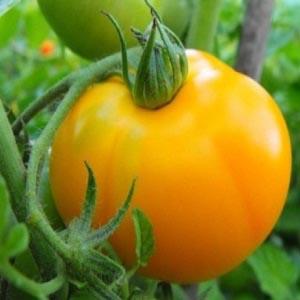 The variety appeared thanks to the works of Russian agronomists. Recommended for cultivation in different climatic conditions.
The variety appeared thanks to the works of Russian agronomists. Recommended for cultivation in different climatic conditions.
A good harvest can be obtained even in the northern regions of our country.
In addition, the Golden Heart can be found in the gardens of the neighboring countries.
Detailed characteristics and description of the variety are presented below.
Distinctive features
Bushes of the Golden Heart are not tall - they can reach a maximum of 1 m. In addition to its benefits, the tomato also has a decorative function, decorates the land.
The bushes have small green leaves of a dark green color. Tomatoes ripen gradually, you can pick ripe vegetables throughout the summer.
The ripening period is about 95 days from the date of planting.
Characteristics of tomatoes, productivity
Gardeners collect about 7 kg of ripe beautiful tomatoes from 1 square meter. Their shape is slightly ribbed, but at the same time, even, heart-shaped. The color is rich, orange-yellow. The tomato got this color for a reason. The fact is that breeders have excluded pigments from the Golden Heart variety, which can cause an allergic reaction in a person.
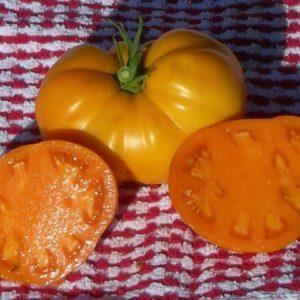
Golden Heart tomatoes are rich in fluoride, iron, potassium and magnesium. What's more, they contain thiamine, folic acid and niacin.
These elements are beneficial for human digestion, have a beneficial effect on the body's nervous system and reduce stress levels. And carotene has a great effect on vision.
The pulp is juicy and fleshy, there are few seeds. The weight of one vegetable is about 160 g, and under more favorable conditions it can reach 230 g. The taste of a tomato is rich, without excess water.
How to grow seedlings
Experienced gardeners for a rich harvest recommend starting the procedure for planting the Golden Heart with seedlings. To do this, you need to prepare the soil, container and seeds.
Seed preparation
Before planting, the seeds must be placed in a small bag and lowered into a glass with a solution of potassium permanganate for 20 minutes. Then you should rinse them with water. Flushing will provide the seed with a more friendly emergence and protect against viruses and fungi.
The next stage of preparation is soaking in a solution based on wood ash. Ash is an excellent fertilizer for both tomato seedlings and ready-made beds..
Similarly, immerse the seed bag in the solution for 12 hours, and then in clean water for 24 hours. This simple operation makes the seeds resistant to weather and builds immunity.
Capacity and soil
The container can be purchased at the store. For example, these will be peat pots or special plastic cassettes for seedlings. However, you can save money and place the seeds in regular plastic jars or buckets. Sometimes gardeners use containers for mayonnaise or other products.The main thing is that the container is clean and dry.
As for the soil, there are two ways here too:
- Make soil for seedlings yourself. The standard set of ingredients is clean soil from the garden, peat, ash, sand or sawdust. Peat absorbs excess moisture and retains it in its pores, while sand or sawdust serves as a loosening agent for the earth. It is best to use river sand without clay admixtures. Also, the use of these components allows for improved drainage.
- Purchase ready-made soil in the store. It already contains the necessary set of nutrients. By its structure, such soil is always loose, so that young bushes can easily get access to fresh air. The purchased land is already cultivated and does not contain fungal spores and dangerous microbes.
Important! If you prepared the seedling soil yourself, be sure to disinfect it with a hydrogen peroxide solution.
Sowing
Pour earth into the container and make small holes. A seed is placed in each of them, sprinkled with earth on top and watered abundantly... It is best to cover the seedlings with glass or cling film. So the plant will give the first shoots faster.
Growing and care
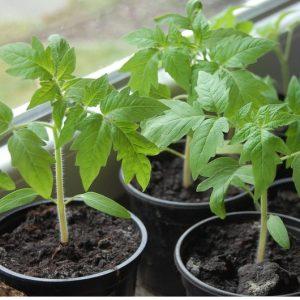 The first shoots appear within a week from the moment of planting. It is important not to miss this moment and remove the film in time. Move the container to the lightest windowsill in the house.
The first shoots appear within a week from the moment of planting. It is important not to miss this moment and remove the film in time. Move the container to the lightest windowsill in the house.
Maintain adequate moisture and spray periodically with a spray bottle. Remember to ventilate, but protect the seedlings from drafts and air conditioning.
It is better to water the sprouts with warm, settled water. 10 days after the appearance of the first leaves, it is recommended to make the first feeding. For example, fertilize with poultry droppings.
2 weeks before transplanting into the ground, hardening is carried out - they lower the temperature in the room by several degrees, opening the vents and balcony doors.
How to grow tomatoes
As soon as the seedlings are ready, it's time to start planting the plant in the ground.
Landing
For the Golden Heart tomato, choose a lighted and wind-protected place on your site. The optimum distance between the bushes should be at least 50 cm. Vegetables are heat demanding, so the ideal temperature for setting tomatoes is 20-25 degrees.
The beds are prepared in advance. In autumn, the soil is freed from debris and remnants of old plants. It is also useful to add a mixture of humus and superphosphate. The main stage of preparation takes place in the spring. You can make holes with your hands or a shovel. It is recommended to plant seedlings in the evening on a cloudy day. So it will take root faster without additional watering.
Care
Watering the Heart of Gold begins on the tenth day after planting.... Tomatoes do not like too moist soil. It causes vegetables to crack and increases the risk of developing fungi and parasitic insects. Gardeners advise avoiding moisture on the leaves and stems. Do not forget to huddle the beds and loosen the ground. These actions saturate the earth with oxygen, making it more favorable for tomatoes.
The plant should be fed at least 3 times per season. Ideally, feeding is recommended every 2 weeks. The vegetable loves nitrogen fertilizers, but try not to overdo it. For mineral dressings, ammonium nitrate or superphosphate are suitable.
Do not forget about pinching bushes. It is recommended to remove additional shoots every 12-14 days. How do they interfere with the bush? The stepchildren take some of the nutrients for themselves, which is why the main stem does not receive the required amount of vitamins. You can remove long shoots with your hands, and short ones with garden shears.
Important! Due to its compact size, the heart of gold does not need to be tied.
Features of cultivation and possible difficulties
When growing Golden Heart tomatoes, gardeners may encounter some nuances. For example, if the leaves turn yellow and dry, then the plant lacks nitrogen.Nitrogen-containing ones will come to the rescue feeding: sodium nitrate, ammonium sulfate, urea.
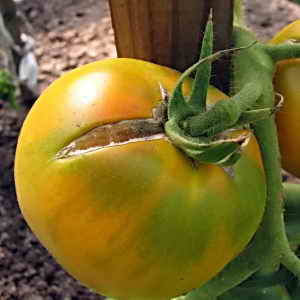
Also, gardeners often complain about the presence of deep cracks in the fruit. The main reason lies in the excess moisture. If it rains heavily during the ripening period of the vegetable, the tomato absorbs water and cracks. Alas, no cures for this have yet been invented.
Diseases and pests
Sometimes the Golden Heart is covered with a white coating. This is the first sign of a disease called powdery mildew. Even if the plant is minimally infected, this is enough to weaken the immune system and reduce resistance to weather changes. Powdery mildew develops in extreme heat and drought.
Another reason for its formation is an excess of nitrogen-containing substances. You can fight it with fertilizers based on phosphorus and potassium.
Important! In addition to powdery mildew, the variety is ill with late blight, black leg, tobacco mosaic. These diseases usually appear due to excess moisture and improper care. In order to prevent their appearance, it is recommended to process the soil and apply ash and other organic fertilizers to it, as well as observe the irrigation regime.
In addition to diseases, a common enemy of tomatoes is the Colorado potato beetle. Pest loves not only potatoes, but also tomatoes. In a short time, the beetle is able to completely destroy the entire crop. It is best to deal with it with the help of chemicals - for example, using the means "Bankol" or "Typhoon".
The nuances of growing in an open field and a greenhouse
Growing the Golden Heart outdoors is complicated by the fact that the plant is not protected from the vagaries of the weather. Low temperatures or humidity create a favorable environment for the development of fungi. The most dangerous enemy of tomatoes is late blight, a type of fungal infection.
The fungus appears as spots on the leaves. To prevent it, you should loosen and water the soil in time, as well as sprinkle the beds with garlic solution for prevention.
If you plant the Golden Heart in a greenhouse, you should pay attention to some features: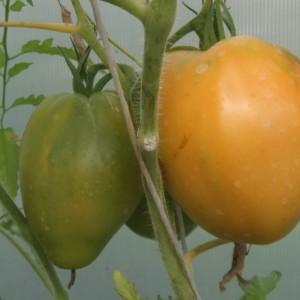
- Remember to periodically ventilate the room.
- Do not let the greenhouse be hot and humid at the same time.
- Examine the plants regularly for discoloration and unusual color of leaves and fruits.
- If you find any disease, take immediate action.
Harvesting and application of the crop
Since the ripening period is long, vegetables are harvested all summer. This allows you to enjoy the juicy taste of the Golden Heart until the beginning of autumn. Some vegetables are consumed fresh, while others are prepared for canning. Due to their small size, tomatoes are great for whole pickling.
In addition, the variety is suitable for preparing various dishes. For example, stuffed tomatoes or sun-dried tomatoes, vegetable stew, or tomato soup. The high content of vitamins will make food not only tasty, but also healthy. Also orange tomatoes will decorate any festive table.
Important! The variety tolerates long-distance transportation and has a high degree of keeping quality. In addition, the Golden Heart is grown not only for personal consumption, but also for sale.
Advantages and disadvantages of the variety
Pros of the Golden Heart variety:
- great taste;
- beautiful appearance;
- versatility in application;
- immunity to diseases and pests;
- long shelf life;
- extended ripening period;
- the ability to ripen at room temperature;
- the ability to grow in different climatic conditions.
Cons: pinching required.
Farmers reviews
On the forums of gardeners there are many reviews about the Golden Heart variety. Here are some of them.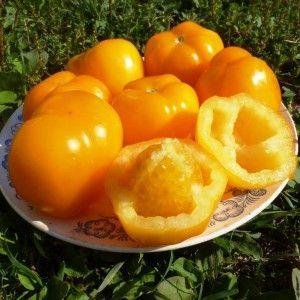
Vladimir from Rostov-on-Don: »Recently I tried to plant the Golden Heart variety on my plot. I didn't think I would like tomatoes that much. I was especially pleased with the appearance - I like bright and unusual varieties. In leaving, I will not say that I spent a lot of time, at least not more than on other varieties.Therefore, I will plant the Golden Heart next year as well ”.
Valeria from Omsk: “I appreciate varieties that are rich in vitamins and other trace elements. From the Heart of Gold I prepare blanks for the winter, and in the summer I eat them fresh. I also like to combine vegetable with fish - they complement each other. If it were not for the removal of the stepsons, I would call this variety ideal. "
Denis from Naberezhnye Chelny: “This is the second time I plant this variety. The first planting was successful, I got a good harvest of ripe tomatoes. But this year something went wrong. 2 weeks after planting, the bushes began to dry. Added top dressing - did not help. As a result, only 7 out of 12 bushes yielded a crop. ”
Conclusion
Many people love heart-shaped bright tomatoes. They are unpretentious in care, they are resistant to diseases. They ripen both in the south of the country and in the Middle lane. Some gardeners prefer open-air beds, and some plant the vegetable exclusively in the greenhouse.
Wherever you plant the Heart of Gold, remember that the main thing is to water the bushes on time, fertilize and loosen the ground.